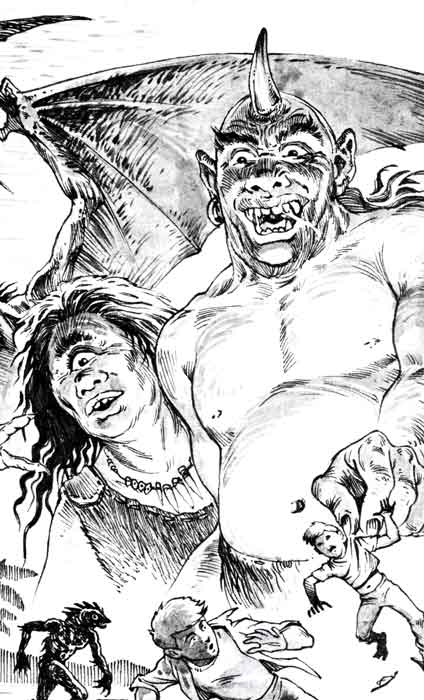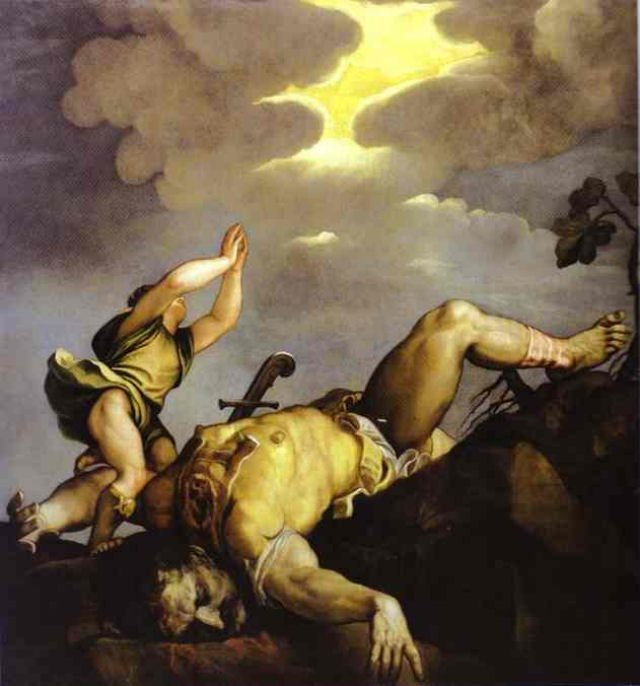They are among the characters you stumble upon in legends and fairy tales. They come in all forms such as the villain or the comedic relief. In some cases, they are even the source of catastrophic earthquakes and other calamities. Notable for their humongous size and monstrous strength (despite their anthropomorphic shape) some consider them to be the “super human” of the ancient past.
Unlike the fabulous beasts from mythology, their previous existence is still being scrutinized and contemplated. Did they really roam the earth or are they simply an allegory? Ideals and archetypes “humanized” by men as they explored their consciousness. Real or hoax, no one can argue that giants aren’t a staple figure that keeps on piquing our interest in tales of fantasy.
Depictions of giants vary in the complex mythology of the Philippines, yet one will always remember the cigar wielding Kapre as the most iconic of all. In reality, giants possess larger roles in our lore, beyond the stereotypical notion that they are mean, nasty or destructive. Such thoughts often come from western stories like “Jack and the Beanstalk”. Let us allow our own myths to give us a new outlook towards the giants of our country.

Giants or Ogres?
Under the classification of lower mythological creatures created by Dr. Maximo D. Ramos, giants and ogres share a similarity due to their massive height and often humanoid features. However, Dr. Ramos differentiates the two in their habits and abode. Giants are known to live in areas away from the bustling of people, while ogres dwell near communities. This is because ogres are by nature, man-eaters and they will try to be near their prey as much as possible.
Another thing to consider between giants and ogres in Philippine Mythology is that they are not always humanoid in shape. Some have an entirely animal physique like the Ikugan – the large simian like creature with a long tail. Others include the Bannog from Ilokano stories, and the Tinguian tale of a giant that resembles a bird. Despite both being extremely powerful in physical aspects, giants and ogres are commonly describe as lacking intelligence and therefore prone to being outsmarted or outwitted by smaller beings.
One may notice that ogres usually have more fearsome features than giants, though both are capable of causing fear. Giants could also be considered to be mischievous, over the more malevolent ogre. Overall, giants in Philippine folklore and mythology are benevolent beings.
The Kind Hearted Ones
As mentioned above, western fairy tales give us the impression that giants are rather ruthless and savage in nature. Symbolically, giants are represented in most mythical tales as the embodiment of chaos; the savageness that is too far away from refinement and order in both spiritual and mental areas. They are also associated with forces of nature that man must learn to survive, or perhaps defeat, to become the ideal “hero”. Hence in the biblical story of David, the young Shepard must kill the giant Goliath in order to become the king and ultimately take the title of hero.

In the Philippines, not all giants are intrinsically evil, although they are still truly a force to be reckoned with. The story of the giant, Gisurab, from the Isneg tribes proves that even a colossal being is capable of showing kindness. In the story, Gisurab was visited by hunters in the wilderness to ask for fire. The giant provides the fire for the hunters so that they may use it to cook their food. The tale somehow reminds me of the Greek narrative about Prometheus, a well-known Titan who is said to steal the fire from heaven to give it to the mortals.
Another being in Philippine lore that deviates from the supposed evil nature of giants is Sibbarayungan from Isneg and Apayao folklore. Despite her unusual status as one of the few giantess to be found in mythology, Sibbarayungan displays a mother-like fondness to a lost man who found himself inside her house. Fearing that her husband, Sappaw, might find out that there is a “meat” in their home, the good giantess hides the man inside a chest. When her husband is no longer in sight, Sibbarayungan gave the man food, water and pointed him in the direction of his home.
…And the Bad to the Bone
Like man himself, giants sometimes struggle between the dual forces of darkness and light; good and evil. Giants who are aligned with the malevolent side are known for their violent tendencies. Ikugan, the oversized simian from Manabo stories use their tails to grab their unwary victims, choke them to death, and then dropped their bodies from the tree.
Bungisngis, the ever grinning giant from Tagalog lore also has a keen sense of perilous mischief. With his large tusks protruding from his lower jaw and cyclopean eye, Bungisngis can easily be put among the roster of ill natured giants – especially when taunting travellers he has spotted, or while he throws Carabao (Water Buffalo) to the ground. It can be said that Bungisngis, in all sense, is a mischievous version of the Greek cyclops.
At times, even the Kapre is notorious for being a trickster; shape shifting and disguising himself to deceive people – especially young maidens (whom they are always easily smitten with). It is said they can take this to extremes when they decided to possess the body of the victimized lass. This may be why they are sometimes labelled as demons or evil engkanto. Evil traits of some Philippine giants might be traceable back to the Daityas, malevolent lords from the Asura race of Hindu lore, who also bordered on evil.

Godlike Status
One would probably be struck by awe if they found themselves face to face with a lumbering giant. Their titanic size seemingly provides an otherworldly aura that makes them more than human, yet they are often described as having the appearance of a man. This leads some to think that giants are actually gods that once ruled the earth. The most prominent myth connected with this theory is perhaps found in Hebrew lore about a race of giants called Nephilim – the offspring of men and fallen angels. This race was known to produce great individuals as well as tyrannical ones which might reflect their semi-divine status.
The theory of giants as gods is also seen in the myth of Angngalo and Aran, the Iloko creation myth about the first man and woman. Their status as gods, unlike the Nephilim, didn’t come as their birthright but because of their acts as creators of the world. In particular, Angngalo, who shaped the whole world through instruction by an unnamed deity.
According to the folklore, collected by Alfredo B. Villanueva and E. Arsenio Manuel, Angngalo, the first being of the world, made the mountains and hills by scooping the earth from the ground and piling it up in different heights. And out of the holes where he scooped the earth, he poured water which become the lakes, rivers and seas. Angngalo and Aran are also responsible in creating the sun, moon and stars. On the other hand, their three gigantic daughters playfully dropped bags of salt in the sea thus making it salty.
There are two branching stories involving Angngalo as the creator of man. One tells that he created the first man and woman from spitting on the ground, while the other is similar to the Tagalog genesis story that man and woman came from a Bamboo plant. What makes the version with Angngalo different is that he left the Bamboo floating in the sea until such time that Lalake and Babae came out of it. In both cases, the giant Angngalo plays the role of a cosmos-builder that typically acted with divine or supernatural qualities on behalf of a supreme being.
Also paralleling the mythological giant theme are stories from Chinese and Norse Mythology. These include Pangu (or Panku) and Ymir, from the poetic Edda, wherein giants are also responsible for the creation of the world.

Larger Lessons to Ponder
Numerous discoveries of giant human skeletons from different parts of the world have gained a lot of attention from both believers and non-believers. Not too long ago, a viral social media post claimed a giant human skeleton measuring up to 17 feet was excavated in Davao Oriental. Areas like Japan and South America have become hotspots for discovering giant human skeletons that were buried tens of thousands of years ago. Will this be enough proof that giants once roamed our world – even perhaps among humans? For now, it seems just as quickly as evidence piles up, it is debunked as a hoax.
Beyond the excruciating struggle of scientifically verifying or debunking evidence of the existence of giants, let us remember what their tales have taught us. Whether they real or not, good or bad, the stories of giants challenge not just our imagination, but also the power of our will to “face the giants” in our lives. Dr. Ramos noted in one of his books that giant lore bears a kind of “emotional release” to small children. This pertains to the triumphs of small and feeble characters against the hulking giants, using only their mustered courage, wit and intelligence. In time, the lessons enforce the idea that even “gigantic” challenges can be overcome – just as the powerless, yet brave and smart mortals managed to defeat the giants in mythology and folklore. In the case of giants, myth becomes as important as truth itself.
ALSO READ: Origin of the Kapre, the cigar smoking giant from the Philippines
Currently collecting books (fiction and non-fiction) involving Philippine mythology and folklore. His favorite lower mythological creature is the Bakunawa because he too is curious what the moon or sun taste like.


